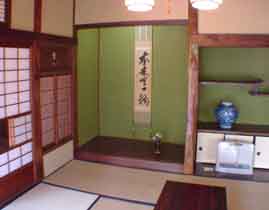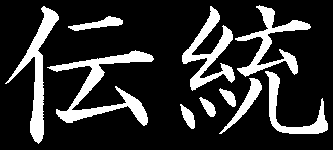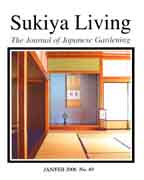|
Japanese Traditional Art
 In
Japan, the traditional approach to art is strongly linked to function and
craftsmanship. If you were somehow able to travel through time and
walk through an Edo-period (1603-1857) home, you would not normally see a
lot of "artwork" displayed on walls or bookcases. Look closely,
however, and you would notice beautiful patterns and creative expressions
incorporated into almost every form of everyday object, from kimono textiles
to calligraphy cases.
In
Japan, the traditional approach to art is strongly linked to function and
craftsmanship. If you were somehow able to travel through time and
walk through an Edo-period (1603-1857) home, you would not normally see a
lot of "artwork" displayed on walls or bookcases. Look closely,
however, and you would notice beautiful patterns and creative expressions
incorporated into almost every form of everyday object, from kimono textiles
to calligraphy cases.
The Japanese home, itself, could almost be considered an art object. Artistic expression can be found everywhere in a sukiya-style structure, from delicate ceiling board arrangements, to carved wooden transoms called ranma, to subtle natural patterns in the wall plaster. Perhaps the most obvious "structural" artwork can be seen in the doors. Thick paper-covered doors called fusuma often display Chinese landscape paintings or Japanese ink paintings of natural scenes. Japanese screens known as known as byobu and tsuitate also typically display fabulous examples of Japanese art. Nowadays those screens are often regarded as pure artwork, but in the traditional Japanese home they were primarily regarded as room partitions and a functional part of the home's structure.
The most obvious "art spot" in a Japanese home would undoubtedly be the tokonoma. The Japanese tokonoma is a sort of alcove built into one wall of a Japanese living room. Its function is similar to that of a mantelpiece in Western homes. Japanese homeowners typically display artwork and prized objects in this space. The display is typically just one or two special objects such as a scroll, calligraphy, a bonsai tree, or a cherished piece of Japanese pottery. The display is typically related to nature and rotated with the different seasons. In the fall you might see a painting of red maple leaves falling on a pond. In the winter you might find a calligraphy poem about a horse pulling a sleigh through the snow.
But in addition to the obvious artwork on display, look more closely and you'll find legitimate art in almost every tiny object used in a Japanese home. Look at the mountain scenes painted on the tea bowls. Look at the natural motifs on the lacquered cases used for storing pencils. Look at the handsome patterns built into the handles of that Japanese tansu chest. Japanese traditional art is actually much more sophisticated than the typical "look at me" attitude of contemporary Western art. In Japan , artistic expression is completely intertwined with daily life and the myriad functional objects that we use as we go about our daily routines. Some Westerners might refer to this type of art as "craftsmanship," but in Japan there is no distinction between the two. The more you understand the Japanese approach to traditional art, the more childish Western art looks in comparison.
Sukiya Living Magazine has published many different articles that are related to these topics. Some of these articles are posted below:
---------------------------------------------------------------
ARTISTIC JAPANESE SCREENS This 4-page article is about Japanese screens. Known as byobu, the Japanese screen is both artwork and furniture. There are two main types of Japanese screens: multiple-panel Japanese screens that fold, and single-panel Japanese screens that have wooden feet to hold them upright. Many of these screens display Japanese paintings of natural scenes.
KAKEMONO The word kakemono refers to artwork that is hung in a Japanese house. Typically displayed in a Japanese home's tokonoma, this category of art objects includes hanging scrolls and calligraphy.
FUSUMA PAINTINGS There are two main types of sliding doors seen in the rooms of traditional Japanese homes. One type is the well-known shoji door, which is made of wood and displays a lattice pattern of white paper. The other is a fusuma door. Fusuma doors are covered on both sides with a sheet of paper. The paper is often actually a real painting - typically of some natural scene. This article talks about those paintings, how they are mounted, and how they are displayed in the Japanese home.
THE ROLE OF THE TOKONOMA If you talk about traditional Japanese art the conversation will undoubtedly include a discussion about the tokonoma. This article defines the tokonoma as well as its role in the traditional Japanese house. The article includes some diagrams of tokonoma for readers who might like to construct one in their own homes.
RANMA The decorative wood transoms seen above Japanese doors are known as ranma. These wooden panels come in many forms, the most common being carvings of animals and natural scenes. This article discusses various aspects of ranma panels.
THE HYOGU-YA PROFESSION There is a type of craftsman in Japan who deals specifically with the artwork displayed on kakejiku scrolls, byobu, and fusuma doors. This article introduces the hyogu-ya profession and outlines some of the most important techniques employed by these craftsmen.
JAPANESE CALLIGRAPHY Anyone who becomes serious about Japanese art will eventually have to deal with the Japanese language (and Japanese calligraphy) to some extent or another. This article introduces calligraphy as a legitimate art form and it explains how calligraphy "art" is normally displayed in the traditional Japanese home.
---------------------------------------

